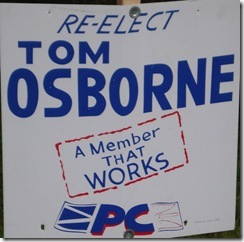Okay so a bunch of people are spilling ink or pixels or whatever over a bunch of new members of parliament elected in Quebec as if they were somehow a special breed of politicians significantly different from any others anywhere else in the country.
Bar managers who have never visited their ridings and don’t speak the dominant language of the riding.
Four university students.
All New Democrats elected in Quebec.
You know the story.
And now a bunch of other people are pointing out that they really aren’t such an odd bunch after all.
Lysiane Gagnon has a column in the Globe that Bill Rowe would crib if he was still column-writing. She rattles off the rather impressive credentials of some of the newly minted politicians.
Susan Delacourt has a blog post over at the Star that is a wee bit more cynical:
Forgive me for dashing any lingering illusions, but the CV has almost nothing to do with winning and losing elections. And it has even less to do with how well MPs fare once they arrive on Parliament Hill.
Geography and gender are equal, if not more important considerations in choosing cabinet. Good looks and an ability to repeat party talking points will score MPs those sought-after spots in Question Period and on TV panels. Doing what you're told counts more than talking about what you know.
Gagnon and Delacourt and all the people who are gobsmacked at the greenness of some of the new MPs are each correct, in their own way.
Anyone out there who thought politicians have all been budding Nobel laureates are basically as full of crap as the cynics who dismiss them all as the progeny of several successive generations of first cousin intermarriage.
Hello, Canadians, these are the sorts of people you’ve been electing to represent you since at least 1867.
They are – not surprisingly - no better than the rest of us.
Nor are they any worse.
Bit of a shocker, eh?
They also aren’t necessarily any different from the politicians we’ve been electing at the provincial or federal level in the past decade or so, at least. Since 2003 in Newfoundland and Labrador, for example, we’ve had a steady stream of politicians whose previous interest in or knowledge of major issues affecting the province has been a bit sketchy. Former cabinet minister Paul Oram demonstrated that pretty clearly in a couple of interviews during a trip to Georgia.
He really isn’t alone. You can find similar displays of fundamental ignorance from former finance minister Loyola Sullivan talking about Equalization or Danny Williams and Charlene Johnson discussing Abitibi’s history in the province or any of a number of pols talking about hydro-electric development in Labrador.
This is not like missing a question on Jeopardy. Politicians get to vote on the laws that govern our lives. Government spending. Criminal code. Access to information. If these politicians don’t really know how things work in the world, then you can figure out that – at least for a while – they are going to make a few mistakes.
Big mistakes, maybe.
Or they’ll be more likely to go with the flow rather than challenge dodgy ideas, like say spending public money without any accountability.
Like in the infamous House of Assembly spending scandal. How many of the newbie politicians took to the improper spending like ducks to the proverbial water only to claim that the rules they found didn’t say you couldn’t do those sorts of things? Pretty much all of them.
Now the people just elected to the House of Commons are, for the most part, a clever bunch. Odds are that they’ll learn. Odds are that many of them will successful politicians.
And in four years time, many of them will be ex-politicians looking for a new job.
Just as they reach the point they should have been at when they started.
- srbp -










